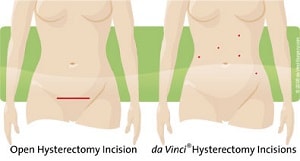Robotic Surgery – Gynecology
Hysterectomy
A hysterectomy is a surgical procedure that removes a woman’s uterus. It is the second most common surgery among women in the United States. It is estimated that one third of all U.S. women will have a hysterectomy by age 60. There are a variety of reasons your doctor may recommend a hysterectomy including abnormal uterine bleeding, chronic pelvic pain, fibroids, endometriosis or cancer.
 Traditionally, a hysterectomy has been performed with a large open incision to gain access to the uterus. This procedure involves a lengthy recovery period and can come with significant pain and trauma to the abdomen. It may also be done non-invasively through the vagina, however, if the uterus is enlarged, you have internal scarring from a prior surgery or some other gynecologic condition, abdominal hysterectomy is recommended.
Traditionally, a hysterectomy has been performed with a large open incision to gain access to the uterus. This procedure involves a lengthy recovery period and can come with significant pain and trauma to the abdomen. It may also be done non-invasively through the vagina, however, if the uterus is enlarged, you have internal scarring from a prior surgery or some other gynecologic condition, abdominal hysterectomy is recommended.
A hysterectomy can be performed through a minimally invasive laparoscopic surgical procedure through a few small incisions in the abdomen. The uterus is removed using special instruments and a tiny camera. The surgeon views the target anatomy on a 2D monitor. Laparoscopic hysterectomy can be challenging for surgeons, in part because of the long-handled, rigid instruments used.
Women now have the option of choosing to have a hysterectomy performed by a surgeon using the da Vinci Surgical System. Through a few tiny incisions and the use of state-of-the-art technology, the surgeon is able to perform delicate and complex operations with superior vision, precision, dexterity and control. The best surgical option for you will depend on your medical history and the complexity of your condition.
Uterine Fibroids
Myomectomy is a common alternative to hysterectomy for treating fibroids. This surgery removes fibroid tumors while leaving the uterus in place. Myomectomy is often recommended for women who want to become pregnant or keep their uterus for other reasons.
As with hysterectomy, myomectomy has traditionally been performed using open surgery with a large incision. After removing each fibroid, the surgeon repairs the uterus to minimize potential bleeding, infection and scarring. Proper repair of the uterus is critical to reducing the risk of uterine tearing during pregnancy. Laparoscopic myomectomy is a minimally invasive alternative to open surgery but is usually not an option for women with large, multiple, or difficult to reach fibroids.
If your doctor has recommended surgery to treat uterine fibroids, you may be a candidate for the da Vinci robotic-assisted surgery. A new category in minimally invasive surgery, this technique involves state-of-the-art technology which enables surgeons to perform this delicate operation with superior vision, precision, dexterity and control.
Endometriosis Resection
da Vinci endometriosis resection allows your surgeon to perform a thorough removal of deeply penetrated or widespread endometriosis while preserving your uterus. Unlike conventional open and laparoscopic surgery, da Vinci endometriosis resection offers the added benefit of computer and robotic-assisted technology, with the goal of minimizing the risk of your endometriosis returning.
 Robotic Hysterectomy
Robotic Hysterectomy